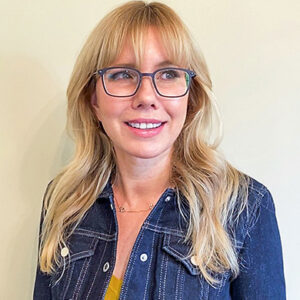Laura Drabik GUIDEWIRE CHIEF EVANGELIST
Well, that just happened. As P&C insurers continue to grapple with the fallout from the hot mess that was 2020, they may want to keep an eye on key technology trends that will gain new urgency in 2021.
Fair warning: The past year was just a warm-up act.

GUIDEWIRE CHIEF EVANGELIST
Despite a few bright spots, COVID-19 has already hit insurers with more than $110 billion in losses from pandemic-related claims, and potentially far more in reduced premium volumes across major lines. And it could be mid-year before vaccines reach anything approaching wide distribution. Longer still before the economy fully recovers.
Meanwhile, the seismic shift we’ve seen in consumer adoption of digital channels for buying and managing insurance will keep expanding. It’ll also fuel rising expectations for digital convenience and value, long after SARs-CoV-2 is safely in the rearview mirror.
Put it all together, and you can see why Guidewire is focused on enabling insurers to engage customers digitally, innovate rapidly, and achieve efficient, sustainable growth no matter how quickly marketplace dynamics change.
Because here’s the thing. The pandemic didn’t create new technology trends. It accelerated them. And most so-called “Black Swan” events like COVID-19, weather-related catastrophes, and cyberattack-driven disasters are actually more like “Gray Rhinos”—sky-high probabilities ignored, rather than unforeseen.
With all of this in mind, here are three insurance industry technology trends that will continue to gain momentum in 2021 (and beyond):
1 The Customer Experience Gets More Personalized—and Proactive
Thanks to digital-first brands like Amazon, Google, and Netflix, today’s most coveted consumer segments have come to expect highly personalized, proactive interactions from every company they do business with—including insurers.
Whether it’s through mobile, IoT, smart home devices, or personal voice assistants, insurers must engage their customers with the right messages and services, at the exact right time, or risk falling behind. To learn more, see https://evangelist.guidewire.com/insights/#insights-videos-section
This includes the deployment of automated, conversational AI-based services that make shopping for policies as easy as saying, “Hey, Alexa,” and filing a claim as simple as capturing images with a mobile phone. It also includes the use of big data and predictive analytics to move from “protection-based” coverage to “engagement-based” models designed to save customers time, money, and energy on an ongoing basis.
Just look at Metromile, CAA, and other insurers that leverage telematics to price auto insurance based on actual miles driven and the policyholder’s personal driving habits. This kind of usage-based insurance (UBI) is expected to grow 50% in 2021, and could account for 20% of all vehicles within the next three years.
Meanwhile, a growing number insurers will start to follow the lead set by Hippo, Aviva, and others that use home-based IoT devices to monitor for things like water and gas line issues, proactively shutting off leaks and preventing small problems from becoming major disasters. There are other models as well. State Farm’s Sundial mobile app and Alexa skill, for instance, helps older adults live independently while enabling family and friends in their “care circle” to do quick check-ins, coordinate tasks, and manage daily activities and appointments collaboratively.
Though not directly related to insurance, connected, value-added services like these create brand affinity and can make a big difference in people’s lives. They also offer insurers additional points of contact that can be leveraged to offer coverage recommendations based on evolving needs—boosting loyalty and lifetime value for the long haul.
2 The Fraud Curve Gets Flattened in the Blink of AI
Consumer adoption of digital channels isn’t the only trend the pandemic has accelerated. Faced with mounting economic uncertainties, cybercriminal rings and otherwise honest consumers and businesses have collectively doubled the assumed fraud rate in claims, according to a new survey from Guidewire partner FRISS.
Today, 18% of claims now include some element of fraud, up from the average 10% seen over the last decade. Seeing sharp rises in the past year: staged accidents, vehicle theft, procedure billing, phantom services, and faked accidents occurring at home.
At the same time, consumers doing legitimate business via digital channels are increasingly impatient with even the slightest delay on a quote or approval on a claim. As a result, look for more insurers to embrace AI, machine learning, and behavioral analytics to assess fraud risk while simultaneously reducing friction for trusted, but increasingly fickle, customers.
Using Guidewire as an example, our built-in capabilities combined with anti-fraud solutions from FRISS, Shift Technologies, Clara and other providers combine AI and machine learning with out-of-the-box business rules to accomplish two objectives. Provide straight-through claims processing for meritorious claims by automating fraud scoring in real time, and support for detecting and investigating fraudulent claims.
With hit rates of 75% or higher, these integrated solutions deliver rich, accurate, real-time fraud scoring that is central to disrupting fraud while delivering fast, friendly customer experiences at every digital touchpoint.
3 Geospatial Analytics Gains Serious Altitude
Remember what I said about Gray Rhinos? While the chaos unleashed by COVID-19 continues to barrage insurers, potentially costlier events are occurring with alarming regularity–including weather related catastrophes.
In North America, damage from tornadoes and other storms caused $21 billion in insured losses during the first half of 2020, the worst losses in a decade.
According to the Fitz Ratings, losses from hurricanes, fires, and other natural disasters may outpace pandemic-related costs for P&C insurers, once final figures are tallied. Recent California wildfires and insured losses from Hurricanes Laura and Sally alone could top $20 billion.
In 2021, look for the combined nature of the pandemic and rising CAT risks to give geospatial analytics new prominence throughout the sector.
Geospatial analytics providers analyze, manipulate, and display data and imagery gathered from satellite and drones. Using computer vision and AI, these providers extract structured data such as roof and property conditions for underwriters, and will increasingly be leveraged to assess damage after natural disasters.
Traditionally, underwriting and claims have involved time-intensive, on-site inspections. As someone who started my career as an adjuster assigned to adjudicate claims after a major hurricane, I can tell you just how arduous, and downright dangerous, onsite inspects can be even in “normal” times.
But when integrated with Guidewire, geospatial analytics solutions from Cape Analytics and Betterview offer insurers improved visibility and actionable insights into damage or risk so they can more accurately price, underwrite, and adjudicate commercial and personal lines.
New Year, Endless Opportunities
If our year of living dangerously has taught us anything, it’s that insurers require a whole new level of agility to achieve new process efficiencies, exceed rising customer expectations, and thrive in an industry where technological trends can (and will) hit the fast-forward button without a moment’s notice.
For insurers, relying solely on in-house resources to attain that kind of technogical prowess is no longer realistic—or even necessary. Today, insurers can quickly switch on new capabilities that take full advantage of the data and functionality built into an existing insurance platform such as Guidewire.
As the insurance industry (finally!) rings in a whole new year, that’s definitely something to cheer about.
For more on analysis on insurance technology trends and insights on harnessing disruptive technologies to gain competitive advantage, subscribe the Laura’s monthly email newsletter, The Drabik Digest


